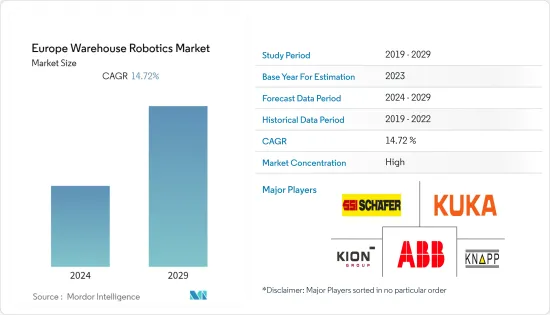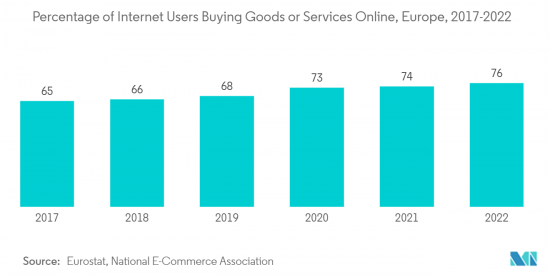PUBLISHER: Mordor Intelligence | PRODUCT CODE: 1403870

PUBLISHER: Mordor Intelligence | PRODUCT CODE: 1403870
Europe Warehouse Robotics - Market Share Analysis, Industry Trends & Statistics, Growth Forecasts 2024 - 2029

The European Warehouse Robotics Market is valued at USD 2.6 billion in 2024 and is expected to register a CAGR of 14.72 percent during the forecast period to become USD 5.16 billion by the next five years. The growth of major industries, such as e-commerce, automotive, pharmaceutical, etc., in Europe and the growing awareness driving the need for efficient warehousing and inventory management are among the significant factors driving the studied market's growth.
Key Highlights
- Automation in warehousing offers extreme convenience by reducing errors in product deliveries and business costs. According to DHL, a 3PL company and a significant end-user of warehouse automation solutions, assisted picking robots to represent a breakthrough in efficiency, increasing the number of items picked per hour by up to 180 percent. Such trends encourage vendors in the warehousing sector to increase their investment in automation and robotics.
- The rising number of warehouses and changing market demand and consumption patterns, coupled with the rise in labor costs and availability of scalable technology solutions in Europe, have driven the market for warehouse robots across European countries. For instance, according to Eurostat, the hourly labor costs in the Euro area rose by 4 percent in the euro area and by 4.4 percent in the European Union (EU) in the second quarter of 2022, compared with the same period of the previous year.
- Further, the emergence of the Industrial Internet of Things (IIoT) and the advent of a network of connected systems are helping industries perform a multitude of warehousing tasks, such as material batching, picking, ordering, packaging, warehouse security, and inspection, as well as improve the operational efficiency by huge margins. Such trends are also creating a favorable growth scenario for the studied market.
- Similar to the global trend, the e-commerce industry has also witnessed significant growth in the European region. The growing demand and trends such as instant/single-day delivery are positively impacting the studied market's development, making the e-commerce warehousing sector among the largest adopters of warehouse robots.
- Moreover, incremental advancement in technology, coupled with a sustained increase in the development of manufacturing facilities, is expected to impact the market growth rate during the forecast period.
- The market growth has been restricted by high costs, preventing mass adoption, especially in the small and medium warehouse segment. Also, the stringent regulatory requirement to use robots in the warehouse hinders market growth. However, the vendors in the market, such as Kuka Robotics, are not only providing robots for lease but have also launched a SmartFactory as a Service initiative to give their customers an option to rent out an entire robot-staffed automated plant.
- The European region was impacted significantly by the outbreak of COVID-19. Countries like Germany, France, Italy, and the United Kingdom were among the majorly affected in terms of the number of infected patients. As several European countries imposed strict lockdown measures, the warehouse industry, already affected by high labor costs, shifted its focus on adopting automation and robotic solutions to ensure compliance with government regulations and efficiently continue its business. With robotics proving highly beneficial, the trend is expected to continue, driving the studied market's growth during the forecast period.
Europe Warehouse Robotics Market Trends
Increasing Investment in Warehouse Automation by E-Commerce Industry to Drive the Studied Market's Growth
- The e-commerce industry in Europe has been gaining traction in recent years. Expanding marketplace, growing internet and smartphone penetration, and shopping convenience are among the significant factors expanding the e-commerce sector's growth in the region. Additionally, the e-commerce industry is also expected to grow further owing to the pandemic-led behavioral changes in customers' shopping patterns.
- According to the 2022 European E-commerce Report by Ecommerce Europe and EuroCommerce, the European e-commerce industry in 2021 grew by 13 percent to EUR 718 billion (USD 783.15 billion); according to the report, the industry witnessed a steady growth despite the pandemic-led restrictions being lifted across the European region and is expected to continue to do so during the forecast period.
- Several e-commerce players are investing in new warehouse technologies to improve work efficiencies, further supporting market growth. For instance, in April 2022, Amazon announced investing USD 1 billion into warehouse technologies to help the company build a supply chain, fulfillment, and logistic technologies. Through this investment, the company aims to improve delivery speed and upscale the experience of logistics and warehouse workers. Furthermore, the company had also acquired Kiva Systems to create wheeled robots for the warehouse and launched several robotic warehouses to speed up the delivery process.
- Furthermore, the increasing number of e-shoppers is also driving investment in warehouse robotics and automation solutions as leading players are focusing on making their supply chain highly efficient and less time-consuming to gain a competitive edge. According to Eurostat and the National E-Commerce Association, the percentage of e-shoppers that purchased goods or services online was expected to grow to 76 percent in 2022 from 74 percent in 2021.
- Considering such trends, several new players are entering the market. For instance, in October 2022, abrdn European Logistics Income PLC, an investment fund specialized in logistics real estate, bought two logistics warehouses, one in Horst, Netherlands, and one in Dijon, France, for an aggregate price of EUR 21.4 million (USD 23.32 million). Such trends are expected to support the European warehouse robot market during the forecast period.

Germany to Hold a Significant Market Share
- Germany is home to many world-famous automobile brands such as Mercedes, Porsche, BMW, Lamborghini, Ferrari, etc., making the country among the largest producers of automobiles in Europe. According to the German Association of the Automotive Industry (VDA), in November and December 2022, about 3,85,700 and 2,53,700 cars were produced in the country, respectively.
- Furthermore, according to Germany's Federal Motor Vehicle Office (KBA), the sales of new passenger vehicles in the country increased by about 38.1 percent to reach 314,318 units in December 2022. Overall, the total annual sales increased by about 1.1 percent to 2,651,357 units.
- As the automotive supply chain involves several warehouses for storing raw and finished products, such trends support the growth of the studied market in the country. Such trends are also attracting new players to enter the country. For instance, in October 2022, Acme Intralog, a UAE-based company, opened a new office in Germany to expand its European operations. The company produces a complete range of AS/RS, conveyors, control systems, shuttles, mini loads, stacker cranes, and other material handling solutions.
- The growth of other major end-user industries of warehouse robots, including e-commerce, logistics, manufacturing, etc., also drives investments in new warehouses, creating opportunities in the studied market. For instance, in January 2023, DHL announced opening a robot picking system at its facility in Staufenberg, Germany, to manage its inventory better. This system comprises 160 robots, which are used to sort orders for clothing store customers across Europe.
- Similarly, in August 2022, Maersk announced its plans to construct a 43,000 square-meter Flow Warehouse in Duisburg, Germany, offering cross-dock, pallet storage, and all value-added services along the supply chain.
Europe Warehouse Robotics Industry Overview
The European warehouse robotics market is concentrated due to higher initial investments. Major players like ABB LTD., KUKA AG, SSI Schaefer AG, KION Group AG, and KNAPP AG dominate the European warehouse robotics market. With a prominent market share, these significant players focus on expanding their customer base across foreign countries. These companies leverage strategic collaborative initiatives to increase their market share and profitability. However, with technological advancements and product innovations, mid-size to smaller companies are growing their market presence by securing new contracts and tapping new markets.
In March 2023, Vanderlande Industries Nederland BV announced the addition of a new automated piece-picking robot in addition to its Smart Item Robotics (SIR) portfolio of technologies and aimed to accelerate the use of robotics for warehousing.
In September 2022, HAI Robotics, a leading provider of case-handling robot systems, and WINIT partnered to boost e-commerce warehouse automation in the United Kingdom. As per this agreement, HAI Robotics had installed about 100 robots in WINIT's warehouse near Birmingham, in central UK. According to the company, these robots walked smoothly in the 30,000-plus-square-meter warehouse to help the workers pick and sort goods.
In June 2022, Amazon Robotics, the robotic business unit of the e-commerce giant, debuted their latest warehouse automation robots: Cardinal and Proteus, the robot arm, and the autonomous floor system, respectively. According to the company, these robots were to be integrated into the same shelf/cell system to enhance the efficiency of warehouses.
Additional Benefits:
- The market estimate (ME) sheet in Excel format
- 3 months of analyst support
TABLE OF CONTENTS
1 INTRODUCTION
- 1.1 Study Assumptions and Market Definition
- 1.2 Scope of the Study
2 RESEARCH METHODOLOGY
3 EXECUTIVE SUMMARY
4 MARKET INSIGHTS
- 4.1 Market Overview
- 4.2 Industry Attractiveness - Porter's Five Forces Analysis
- 4.2.1 Bargaining Power of Suppliers
- 4.2.2 Bargaining Power of Buyers
- 4.2.3 Threat of New Entrants
- 4.2.4 Intensity of Competitive Rivalry
- 4.2.5 Threat of Substitute Products
- 4.3 Industry Value Chain Analysis
- 4.4 Impact of COVID-19 on the Market
5 MARKET DYNAMICS
- 5.1 Market Drivers
- 5.1.1 Increasing Number of SKUs
- 5.1.2 Increasing Investments in Technology and Robotics
- 5.2 Market Restraints
- 5.2.1 Stringent Regulatory Requirements
- 5.2.2 Hight Cost
6 MARKET SEGMENTATION
- 6.1 By Type
- 6.1.1 Industrial Robots
- 6.1.2 Sortation Systems
- 6.1.3 Conveyors
- 6.1.4 Palletizers
- 6.1.5 Automated Storage and Retrieval System (ASRS)
- 6.1.6 Mobile Robots (AGVs and AMRs)
- 6.2 By Function
- 6.2.1 Storage
- 6.2.2 Packaging
- 6.2.3 Trans-shipments
- 6.2.4 Other Functions
- 6.3 By End-user Application
- 6.3.1 Food and Beverage
- 6.3.2 Automotive
- 6.3.3 Retail
- 6.3.4 Electrical and Electronics
- 6.3.5 Pharmaceutical
- 6.3.6 Other End User Applications
- 6.4 By Country
- 6.4.1 United Kingdom
- 6.4.2 Germany
- 6.4.3 France
- 6.4.4 Rest of Europe
7 COMPETITIVE LANDSCAPE
- 7.1 Company Profiles
- 7.1.1 ABB Ltd
- 7.1.2 KUKA AG
- 7.1.3 SSI Schaefer AG
- 7.1.4 KION Group AG
- 7.1.5 Mecalux SA
- 7.1.6 KNAPP AG
- 7.1.7 Kardex AG
- 7.1.8 Viastore Systems GmbH (Toyota Industries Corporation)
- 7.1.9 BEUMER Group GmbH & Co. KG
- 7.1.10 Vanderlande Industries B.V.
- 7.1.11 Siemens AG
8 FUTURE OF THE MARKET
9 INVESTMENT ANALYSIS




